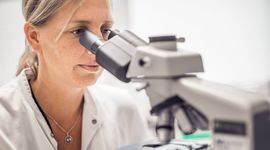Using machine learning for biomarker discovery: A promising path to early RDEB cancer detection
New scientific publication from the Working Group Wally
In this study, researchers of the EB house used a powerful technique called machine learning to find potential biomarkers for the highly aggressive skin cancer (squamous cell carcinoma; SCC) in people with recessive dystrophic Epidermoylsis bullosa (RDEB). SCCs are the primary cause of death in RDEB and timely detection is crucial to facilitate prompt tumor excision. Currently, the detection of RDEB SCC requires invasive skin biopsies with a high burden for patients.
Here, the researchers investigated whether short RNA molecules called miRNAs could serve as a reliable biomarker to detect this aggressive cancer. These miRNAs are not only found in tumor cells, but also in tiny particles termed exosomes, which are released by tumor cells into the bloodstream. Therefore, a simple blood test, known as liquid biopsy, could provide evidence of SCC.
Machine learning has been proven to be a powerful tool in the identification of miRNA tumor markers, but its use is impeded in RDEB tumors due to small patient numbers. To overcome the challenge of limited RDEB patient samples, the researchers compared the miRNA patterns of RDEB SCC to those of other cancers from a large cancer database. Due to the similarity in miRNA profile with RDEB SCC, they used miRNA data from head and neck (HN) SCC. Using this information, they developed a computer model that has the ability to distinguish between tumors and normal tissue, based on a small set of miRNAs. Additionally, the scientists demonstrated that this model could accurately predict whether exosomes are derived from tumor or normal cells.
Overall, this study demonstrates that machine learning and publicly available data can help identify miRNA “signatures” that could be used as diagnostic markers for early detection and monitoring of SCC in RDEB patients. While more research is needed to validate these findings in a clinical setting, this study lays the foundation for a future less invasive diagnostic tool for RDEB SCC.
To access the article, please click here
